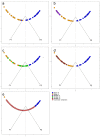Transcriptional profiling of Plasmodium falciparum parasites from patients with severe malaria identifies distinct low vs. high parasitemic clusters
- PMID: 22815802
- PMCID: PMC3399889
- DOI: 10.1371/journal.pone.0040739
Transcriptional profiling of Plasmodium falciparum parasites from patients with severe malaria identifies distinct low vs. high parasitemic clusters
Abstract
Background: In the past decade, estimates of malaria infections have dropped from 500 million to 225 million per year; likewise, mortality rates have dropped from 3 million to 791,000 per year. However, approximately 90% of these deaths continue to occur in sub-Saharan Africa, and 85% involve children less than 5 years of age. Malaria mortality in children generally results from one or more of the following clinical syndromes: severe anemia, acidosis, and cerebral malaria. Although much is known about the clinical and pathological manifestations of CM, insights into the biology of the malaria parasite, specifically transcription during this manifestation of severe infection, are lacking.
Methods and findings: We collected peripheral blood from children meeting the clinical case definition of cerebral malaria from a cohort in Malawi, examined the patients for the presence or absence of malaria retinopathy, and performed whole genome transcriptional profiling for Plasmodium falciparum using a custom designed Affymetrix array. We identified two distinct physiological states that showed highly significant association with the level of parasitemia. We compared both groups of Malawi expression profiles with our previously acquired ex vivo expression profiles of parasites derived from infected patients with mild disease; a large collection of in vitro Plasmodium falciparum life cycle gene expression profiles; and an extensively annotated compendium of expression data from Saccharomyces cerevisiae. The high parasitemia patient group demonstrated a unique biology with elevated expression of Hrd1, a member of endoplasmic reticulum-associated protein degradation system.
Conclusions: The presence of a unique high parasitemia state may be indicative of the parasite biology of the clinically recognized hyperparasitemic severe disease syndrome.
Conflict of interest statement
Figures



References
-
- WHO. World Malaria Report. 2010.
-
- WHO. Severe falciparum malaria. Trans Roy Soc Trop Med Hyg. 2000;94:S1/1–90. - PubMed
-
- WHO. Severe falciparum malaria. Trans R Soc Trop Med Hyg. 2000;94:1–90. - PubMed
-
- Marsh K, Forster D, Waruriru C, Mwangi I, Winstanely M, et al. Indicators of Life-Threatening Malaria in African Children. N Engl J Med. 1995;332:1399–1404. - PubMed
Publication types
MeSH terms
Grants and funding
- K23 AI079402/AI/NIAID NIH HHS/United States
- R01 GM074024/GM/NIGMS NIH HHS/United States
- 5K23AI072033-05/AI/NIAID NIH HHS/United States
- K23AI079402/AI/NIAID NIH HHS/United States
- HHMI/Howard Hughes Medical Institute/United States
- R01GM074024-07/GM/NIGMS NIH HHS/United States
- K23 AI072033/AI/NIAID NIH HHS/United States
- R01 AI034969/AI/NIAID NIH HHS/United States
- R01 CA121941/CA/NCI NIH HHS/United States
- 5R01AI077623-05/AI/NIAID NIH HHS/United States
- 5R01AI034969-14/AI/NIAID NIH HHS/United States
- R01CA121941/CA/NCI NIH HHS/United States
- R01 AI077623/AI/NIAID NIH HHS/United States
LinkOut - more resources
Full Text Sources
Molecular Biology Databases
Miscellaneous

